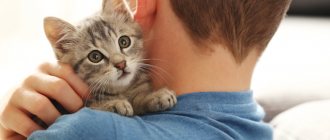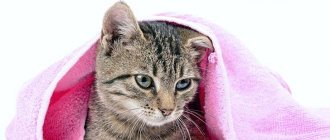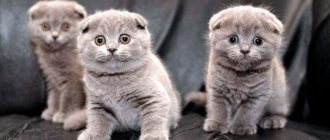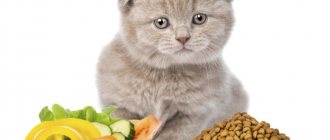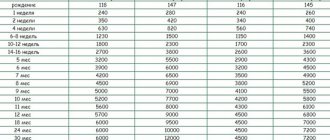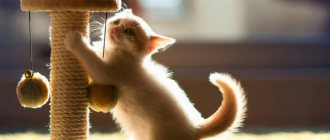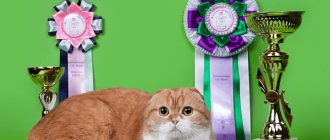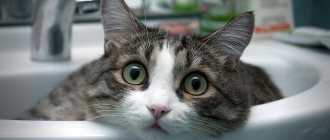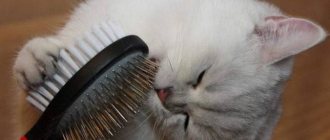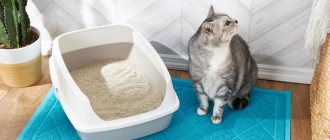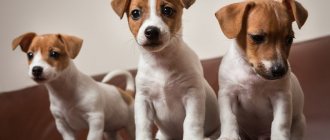You can buy a British kitten from us. Minsk. +375 (29, 44) 7-222-444
If you have decided to get yourself a kitten and, while browsing the Internet, you don’t know the difference between a British kitten and an ordinary kitten, this article is for you.
Looking at a kitten as a whole, it is not always clear how purebred the animal is. Details matter here. It is in professional nurseries that the kitten and its standards are carefully and carefully studied. Additionally, at the age of about 2 months, kittens are brought to the club for a full examination of the animals and their selection for the breed.
Any nursery will be able to provide you with documents confirming the purebred of the animal - metrics, pedigree of the kitten and its parents. If a breeder offers you to purchase an animal without documents, the question of its origin 100% arises. Since interbreed matings are prohibited and no phenological organization will issue documents for such a litter of kittens. Therefore, those who often sell “purebred and purebred” kittens without documents at a cheaper price offer mestizos.
HOW MUCH DO THE DOCUMENTS COST? WHY OVERPAY?
Real purebred kittens that have been checked by a veterinarian and a breed expert at the club are issued documents. If the kitten is healthy physically, genetically, and there are no deviations in psychological health, a document is issued for it and an identification number is assigned (it is not repeated anywhere else in the world). And the documents themselves are worth nothing.
If the animal with documents is a purebred animal
If without documents - perhaps mestizos, marriages due to health reasons, injuries, incorrect matings, mongrel animals
You should be alarmed by the information that documents were not issued for the kitten. What's the matter? Is the kitten out of breed? Does your kitten have health problems? He cannot relate to the breed due to his unhealthy psyche and deformities? Be careful. Let's make a reservation once again - documents cost nothing . Documents are issued only for healthy and purebred animals!
WHERE TO FIND A PEDIGREE ANIMAL?
In the nursery. And only in the nursery.
When buying an animal at the market, you need to understand that a real breeder of the British breed will never take his pets there. But mestizos are most often sold there. The worst thing is not buying a kitten at the market, it’s worse when the animal may show hidden diseases or genetic problems; hundreds of people pass by at the market and everyone tries to touch the kitten with dirty hands. Let’s not even talk about the stress the poor animals get from such a pastime.
And if you buy a kitten on the market, you won’t be able to find such “breeders” during the day and won’t hold them accountable. You won’t believe the lengths to which they sometimes resort to passing off an ordinary kitten as a British one. They can even be painted with paints. And this is the lesser of the evils. What we haven’t seen in practice...
It would be much better to find a nursery or breeder who specializes in the British breed. View the pedigrees of the parents. In the pedigree, you will see the BRI/BRL coding for parents, grandmothers and great-grandmothers - British breed.
Don’t rush, even if you want to bring your baby home sooner, for example, at one and a half months. A good breeder will not want to give you his kittens before 3-4 months. If, on the contrary, you are offered to pick up the kitten earlier, pay attention to this. Up to 3-4 months, babies still eat their mother's milk, learn to go to the tray, serve, wash themselves, and get used to the scratching post. The kitten’s psyche is also formed.
HOW TO CHOOSE A KENNEL WHERE YOU CAN CHOOSE A KITTEN?
Let's talk about all the moments of choice that play a big role. In addition to quality nutrition and well-groomed appearance, there are many factors.
SIGNS OF A GOOD KENNEL
- The house should have clean trays, bowls, beds, and a mother cat's box where she feeds the babies.
- There should be no smell of urine. At home there are always: scratching posts, house complexes, toys.
- Ask to see the documents: if it is a good nursery and a reputable breeder, he will always show the nursery’s certificate, the pedigree of the mother and father of the kittens (there should not be Scottish, Persians and other breeds - only British).
- There should not be too many animals in the house; the optimal option is 1-3 adult pets.
ABOUT CHOOSING A BREEDER
The cattery breeder must be sociable, friendly, competent, know a lot about the breed and always love his pets. You should be wary if he forces you to buy a kitten.
ABOUT CHOOSING KITTENS
- Kittens should be active, inquisitive, playful, healthy and well-fed.
- The general appearance is well-groomed.
- Kittens, if kept with love and care, will be accustomed to hands and people; they should not hiss or show aggression in any way. It should also be noted that the British, as a rule, do not like to sit in their arms, so if the baby breaks free, let him go, in this case, “hand training” means sociability, responsiveness, babies should be willing to make contact, play with You, and not hide in the corners.
PARENTS OF KITTENS - ANOTHER IMPORTANT ARGUMENT
It will be great if you look at the adult animals - the mother and father of the kittens. They must be healthy, well-groomed, and have good breed characteristics.
If one of the parents does not live nearby, you can ask for a photo or video of the animal, and also watch it at exhibitions.
HOW TO CHOOSE A HEALTHY BRITISH KITTEN?
- Eyes, clear, shiny (small transparent (!) discharge is allowed due to breed characteristics)
- nose wet, cold
- ears are clean, without black spots
- mucous membranes are clean
- ponytail: check for the absence of creases (draw from base to tip - it should be even)
- bite: teeth should be white, even, positioned in accordance with the norm
- fur without bald spots, red spots, wounds, etc.
HOW TO DISTINGUISH A BRITISH CAT FROM A REGULAR CAT: FEATURES AND SIGNS
| British | Regular | |
| Ear shape | small, rounded, have a wide base | quite narrow, medium to long length |
| Ears set | set wide apart, forming a regular triangle (90 degrees), extending from the base of the ears to the tip of the nose | the landing is high, they often look “rabbit-like” |
| Head | large, round (even slightly elongated to the sides), the chin forms the signature British “smile”. The neck is strong, short | small, triangular, elongated muzzle in profile |
| Eyes | the eyes are widely spaced, large, round, open. Eye color is bright and rich: orange, green, blue | set closer than those of the British, eyes of medium size, often insufficiently colored, have a pale yellowish-greenish color |
| Nose | The British nose is of medium size, wide at the base. The bridge of the nose should be as wide as possible and, as it were, “spread” in both directions | long, narrow nose |
| Cheeks | clearly expressed, the wider the better | the absence of such a feature in outbred cats |
| Body | compact, knitted, heavy. The chest is wide and convex. Powerful and wide back. The body is medium to large in size, muscular. | elongated, long along the back |
| Paws | paws are squat, thick | paws are thin, high |
| Tail | the tail is dense, thick, medium or short, tightly padded. The tip of the tail is round | tail: medium to long, thin, mobile |
| Wool | the wool is soft, plush, dense, short, has a double undercoat, tightly padded | the coat is hard, rather long, mostly guard hairs without dense undercoat |
| Backbone | wide, heavy frame | narrow back, lightweight bones |
| Color | There are strict standards for colors. Today there are more than 200 types of colors. Very rare colors have been bred: gold, silver, chinchilla, cinnamon/fawn, etc. The breed contains solid colors (which is rare in outbred cats), as well as forms of lightened colors: chocolate, blue, lilac, cream. | Dominant color forms predominate: black, red (red), spotted, with white |
DISTINCTIVE CHARACTER FEATURES OF BRITISH CATS
Based on experience, we will describe general information on behavioral characteristics and character depending on the breed.
British kittens are bundles of cuteness that you can stare at for hours. However, it is not uncommon for people to purchase animals under the guise of British that are similar to them, but are not. In order not to fall for the tricks of sellers and not give money for a crossbreed, you should know the differences between these cats and their own kind.
Thai cats and their differences from mixed breeds
At the turn of the 19th and 20th centuries, Siamese cats appeared in England, but people noticed that they differed from each other in body structure and divided the breed into two types:
- cats with a strong build and rounded heads are the ancestors of today's Thais;
- graceful with an elongated muzzle - Siamese.
The Thais interested scientists and work began to improve the breed. As a result of the work, today there are three types of Thais: classical, traditional and modern.
Purebred Thai cats should have a large round head with a high forehead and a convex, powerful sternum. Almond-shaped eyes and set ears prove that the breed came from the East. Thanks to numerous crossings, the standard color of the Thais was diluted with cream, red, tortoiseshell and tabby (brindle).
By nature, these are loyal, balanced cats with high intellectual abilities, very sociable and able to change intonation.
A mixed-breed Thai cat, after crossing with a barn cat, has a pronounced external resemblance to the breed, but is fundamentally different in character due to its unbalanced psyche. Such mestizos can be aggressive and angry. This is due to the instinct of a hunter who is forced to defend his territory in the street.
If a mestizo comes from different breeds, then the traits of both parents will be visible in the character and appearance.
How to distinguish a British kitten from an ordinary one
The peculiarity of the British breed is its short hair. Neither kids nor adult representatives can be shaggy and fluffy . Breeders are recognized as spotted cats, all representatives of the tabby color, as well as tortoiseshell and mackerel. In order to slightly diversify the appearance of the animals, it was decided in 1980 to begin crossing them with Siamese cats. This resulted in Britons with bizarre markings.
The characteristic differences between a British kitten and an ordinary kitten are:
- Massive but round head shape. The animal's cheeks are large, unlike its ears - they are wide, but small, and are still slightly rounded at the ends. Regardless of whether the family lives with a cat or a tomcat, the animal will be large in size, with a wide chest, massive back and shoulders. The British are called "collected" because their body length is short, but the breed is large. The animals boast a thick but medium-sized tail.
- Restraint and willfulness. The British cannot be called temperamental. Cats, like true Englishmen, are accustomed to keeping their emotions to themselves. It is not surprising that it is representatives of the described breed who serve in the library of the Queen of Great Britain. Animals are unobtrusive and do not follow people around. On the contrary, they prefer solitude and tranquility.
- Nose shape. The British are similar in appearance to Straights and Carthusian cats. However, only in the presented species the nose is curved and resembles a duck’s.
History of cats and their breeds
Cats and cats are creatures of nature, and their preferences are natural. To procreate, they choose a couple based on certain criteria, where strength, endurance and health come first, and only then external data. The domestication of cats began about ten thousand years ago, and at that time all cats did not have a specific breed, but living in different areas, they differed in appearance and character.
As cats from different areas spread throughout the world, they crossed with each other and the first mestizos appeared, which, in turn, continued to reproduce. This is how modern cats appeared, which differed in physique, length and color of fur, and character. With the development of progress, the study of genetics began and the identification of the causes of differences in the color and character of pets began, as well as their unification into separate groups - breeds.
All breeds have their stories:
- Some arose naturally without human intervention, such as the Siamese cat.
- Others are bred artificially, through long-term crossings of different species. One of the representatives is British. In fact, this is a mixed-breed cat whose parents were English and Persian domestic cats.
- For still others, the main distinguishing feature of the breed is caused by a gene mutation, for example, in Scottish cats it is folded ears. Subsequent work was aimed at preserving such features.
Today there are more than 400 cat breeds.
Character of British cats
You can indirectly determine a British kitten by its character. The kids are calm and serious. Animals can be quickly trained to do something without much difficulty. Of course, kittens are very playful, like all felines, but they prefer to play alone. It is enough to make one toy for them so that they do not do mischief, and that will be more than enough.
With age, animals become imposing and proud. Felines try, on the one hand, to stay away from people, but on the other, to make sure that they still get time. The British are devoted to their owners and miss them greatly when they are away, but the animals will never show it. If you want to have such a furry friend in your house, then you can choose a girl kitten (because “ladies” are more affectionate) and give all the kindness to your favorite.
What are the good things about mestizos?
Despite the fact that mestizos cannot become winners of exhibitions, such cats can be kept as a faithful companion. They will delight you with their company and will not cause much trouble, because, unlike their purebred counterparts, mestizos are different:
- Health. Having a stronger immune system, the mestizo gets sick less often.
- Intelligence - much easier to train and get used to the tray.
- Unpretentiousness in food.
The character of a mestizo is formed from the characteristics of the breeds of his parents. Both maternal and paternal qualities or both may predominate in it. In terms of skeletal structure and aesthetic characteristics, a mixed-breed cat may be superior to its parents, but it will never become an exhibition winner.
How not to buy a fake British
There are plenty of unscrupulous people everywhere, and especially those who are happy to profit from the ignorance of others. Therefore, when choosing a kitten, you should be very careful.
- It is recommended to buy animals from trusted breeders who have been breeding British dogs for years and have proven themselves to be the best.
- Be sure to ask for all documents. Pedigree animals visiting the exhibition (and not only) have them. Kittens are also given documents confirming their pedigree.
- Study thoroughly what kittens should look like and only then make a purchase.
- Don't rush into purchasing. Some people want to pick up their babies at 1.5 months, when the fur coat and eyes have not yet changed color. The desire to bring a kitten home can turn into deception.
Each color of the British has its own price, which you need to familiarize yourself with in advance. If the seller reduces the price, hoping that the buyer is not aware of it, this is an obvious catch.
Knowing simple rules, you can buy a purebred British dog that will delight its owners for many years.
The British are the aristocrats of the cat world. Looking at them brings incredible aesthetic pleasure. If you desperately want a cat that will add comfort and warmth to your home, but are afraid that you won't have enough time for a pet, the British is the right breed.
British cream cat
Beautiful, or better yet, luxurious, independent and charming animals with a calm disposition. What's the catch? It would be a lie to say that there is none. Before purchasing a plush kitten, it is better to learn in more detail some points about the character of the British. Then, if you decide that such a pet is ideal for your temperament, do some research on hereditary diseases in the British.
The British cat breed is exactly the option when the miser pays twice. Advertising sites are full of inexpensive kittens. On the other hand, the price for a kitten from a nursery can reach 15-50 thousand rubles. Where does such a range of prices come from and is there any point in overpaying? You need to figure this out on your own. After all, breeders of any price category have their own selfish interest - to sell kittens, so all their words and statements must be considered from a critical point of view.
The best age for a British kitten to move to a new home
Physically and psychologically, kittens will be ready to leave the nursery at 3 months. By this time, club activation, vaccination and quarantine will end.
On a note!
Despite the recommended age of 3 months when a kitten can be picked up, you need to choose a baby in advance - at about 1.5 months of age. At this age, the future owner can already assess the pet’s natural characteristics, its color and level of development.
About a month and a half after the birth of the litter, the breeder opens reservations for kittens. Now you can start making reservations. This can be done either directly or online, because many breeders keep up with the times and try to keep in touch with clients via the Internet. This helps a lot when the breeder is located in another city or even country. In this case, clients can receive all the necessary information and even meet the kitten in person via Skype or on the website.
The cutest cats in the world: the appearance of the British
The British cat is the embodiment of “blue blood”. When a person says “I have a purebred cat,” then most often we imagine an imposing British cat. Their appearance has become the ideal of feline beauty for millions of people: the breed is second in popularity only to the Scottish Fold.
Britons are quite large animals. Males weigh 5-8 kg, females about 4 kg. Pedigree characteristics are most clearly manifested in cats. Their silhouette looks squat (short, strong legs), and all shapes are soft and rounded. The tail is thick and short, with a rounded tip. Cats look very harmonious and proportional.
British silver chinchilla cat
A separate song can be dedicated to the head of British cats. Those cheeks! The head looks round no matter which way you look at it. A wide skull, a pronounced massive chin - the British cat personifies strength and solidity. Round, dense cheeks give the impression that the cat is constantly smiling into its whiskers.
The British have a recognizable head shape
The large round eyes of the British have a breed feature: a bright copper color. Exceptions are allowed for certain colors: silver cats will have green eyes, while pure white cats may have blue, yellow or different colored eyes. Cats of the so-called “Siamese color” (colorpoint) always have blue eyes.
British blue cat: bright copper eyes are magnificent
British cats of a certain color have an unusual phenomenon - eyes of different colors.
British bicolor cat with heterochromia
You can read about heterochromia and see more photos of different-eyed cats HERE (the link will open in a new tab).
And a little about secrets.
The story of one of our readers, Irina Volodina:
I was especially distressed by my eyes, which were surrounded by large wrinkles, plus dark circles and puffiness. How to completely remove wrinkles and bags under the eyes? How to deal with swelling and redness? But nothing ages or rejuvenates a person more than his eyes.
But how to rejuvenate them? Plastic surgery? I found out - no less than 5 thousand dollars. Hardware procedures - photorejuvenation, gas-liquid peeling, radio lifting, laser facelift? A little more affordable - the course costs 1.5-2 thousand dollars. And when will you find time for all this? And it's still expensive. Especially now. Therefore, I chose a different method for myself.
In all feline systems, interbreed matings are prohibited. A purebred animal, in particular the Maine Coon, has distinctive characteristics. With uncontrolled reproduction, these qualities are lost. It is impossible to predict what kind of cross between coons and their yard brothers will be, but genetics has long identified several rules for the inheritance of traits.
Read in the article:
What breeds were involved in the creation of British cats
British cats are considered by some to be an aboriginal breed - one that formed on its own, without active human intervention. In many ways this is true. Cats were brought to the islands of Great Britain by Roman legionnaires many years ago. On an island isolated from the mainland, the cat population developed “in itself”, without the infusion of fresh blood, but with strict natural selection. After all, cats did not live in houses, but on farms, fields, grain barns and factories. As a result, large cats with heavy bones and dense, thick short hair roamed the streets of England.
British cream color
At the end of the 19th century, targeted selection of British cats began, and for some time the breed was called the “British Blue”. At first, blue was the only acceptable color, then it was the most common, but now the variety of colors of the British is amazing.
"Classic" blue color of British cats
The breed's numbers declined twice in the 20th century - after the First and Second World Wars. In order not to lose the British, they were crossed with ordinary outbred shorthair cats. And in order to return the desired rounded appearance of the head, they began to involve in the breeding of Persians.
It was not possible to obtain stable offspring, and the British began to be mated with Russian blue cats, as well as Chartreux cats. Then they returned to the infusion of Persian blood, weeding out kittens that were too snub-nosed or had long hair. It was the Persians who “gave” British cats more than 200 variations of coat color.
In 1982, the two breeds were finally separated: British and European Shorthair. At the same time, the British breed standard was written.
Unusual cat breeds
For you, is a cat not only a pet, but also a way of self-expression? Take a closer look at unusual cat breeds. This is where you should choose to suit your taste!
Cats with original appearance
There are people who want to be unique even in choosing a pet. If you want your friends to admire your cat, take a closer look at these breeds:
Curly curled ears
A cat with the appearance of an alien
Curly fur and graceful posture
Pet with large curls
Cute cat with short legs
Peterbald
Elegant cat with smooth skin
Cats with an unusual appearance will also delight you with a wonderful character. Some of these breeds are not cheap - but you can overpay for such pleasure!
Resembling wild cats
Some people want to bring something exotic into their normal lives: bring home a real leopard! However, a leopard is a dangerous undertaking. Then choose a domestic cat breed in a wild shell:
Domestic inquisitive leopard
Black panther with a homely disposition
A mischievous fidget with the appearance of a wild cat
Savannah
African animal for your home
With such cats you feel like you are in the jungle: their unusual appearance contributes to this. All breeds, except the Bombay, truly have wild roots.
Plush on the outside, tough on the inside. The character of the British.
When you look at the cheeky little plush, round on all sides, you have an uncontrollable desire to squeeze the Briton endlessly. And here you will be greatly disappointed - British cats do not tolerate familiarity! Although kittens may willingly play with their owner and cuddle, adult cats behave more than independently.
Silver tabby kitten plays with a teaser fishing rod
They rarely or never come to sit on your hands. If you start stroking a pet that is sleeping or minding its own business, the cat will most likely leave, or prove that sharp claws are hidden in its soft paws. All that remains is to humble yourself and caress the Briton only with your eyes.
The owners of these luxurious cats admit that sometimes they do not feel like their owners. Sometimes it seems that everything is the other way around: Mister Cat lives in the apartment, the rest are service staff.
“I am the queen, and you are the two-legged food giver.”
This does not mean that British cats do not need love and care. They seek attention from people just like other cat breeds - but only on their own terms. A curious animal may simply follow you from room to room, carefully observing what its person is doing.
The manners of the British are inherently respectable; they rarely rush around the apartment or jump on cupboards. If you get used to the scratching post in a timely manner, you won’t have to worry about the furniture. They are not mischievous or annoying.
British chocolate cat
British cats only vocalize on special occasions. If we are not talking about sexual heat or severe stress (a trip in the car, a visit to the veterinarian), some owners do not hear their pet meowing for months. Meowing while begging for food is beneath the dignity of these aristocrats. Rather, you will be haunted by the gaze of large round eyes, reproachful.
In general, the breed is considered quite phlegmatic: the British have a calm and even character. To prevent your pet from completely turning into a sofa cushion, excess weight should not be allowed to appear.
British cats are not a suitable breed for families with children. Rarely does a Briton favor children: they are too noisy, too clingy and lacking in delicacy. No, a cat is unlikely to scratch a child, even if he pulls his tail. But the life of a Briton will turn into constant stress and the search for a reliable refuge, where no one will disturb him to take a peaceful nap. These cats are not ready to play for too long, and even more so, they do not like to be persistently petted. Explaining to a child that this teddy bear is inviolable will not be easy.
Get your little hands off me, little man!
Problems and breeding
A decent breeder will never approve of the meaningful mating of a coon and an outbred female. This often leads to the following consequences:
- A cat may die in childbirth if the kittens are very large;
- The purity of the breed is lost;
- You cannot conduct breeding activities with a half-breed;
- Unpredictable animals in terms of mental health and health.
As a rule, mestizos are sold at low prices. They are of no interest and lose value for breeding. The work of the breeder is highly appreciated. The price for a purebred kitten cannot be below a certain level.
Differences between a coon and a purebred kitten:
- Large sizes;
- Recognizable muzzle profile;
- Large ears, possibly with a tassel;
- Semi-long topcoat;
- A long tail;
- Strong bones;
- Wide chest.
Usually a cross between Coons and nobles looks simpler.
Even purebred animals with minor defects or weak types are sterilized to prevent them from producing offspring. Sometimes even experienced people have unforeseen circumstances when a Maine Coon mates with a noblewoman. Even in this situation, animals are given away free of charge or for a symbolic amount, with the condition of mandatory sterilization in the future. Before buying a coon, you should look at his parents, find out their origins and study pedigrees. The breeder always hands over the documents (metrics) of his graduates. Otherwise, there is a risk of acquiring an outbred animal. Kittens move to a new home no earlier than 3 months, after vaccinations and other necessary procedures. Mestizos are usually given away earlier due to the high costs of raising them.
In the recent past, there have already been attempts to register non-purebred coons. Several breeds were used to breed them:
A similar situation is observed in the dog world, but there designer breeds have become successful due to their cute appearance and clever advertising. Both types of kuna hybrids have remained unrecognized by the felinological community. The work did not live up to the hopes of the breeders. The resulting kittens turned out to be of different types, without the desired characteristics.
Problems also arise when cat owners realize they don't have a coon. Many raised animals end up in shelters or worse, on the street. Growing up at home, they cannot withstand the difficulties they encounter on their own. In addition, uncontrolled reproduction begins, and the number of street children is rapidly increasing. They are susceptible to infections, their immunity is weakened, and the infection spreads further.
Is it difficult to keep a British cat?
You have to pay for everything - and in the case of the British, you have to pay for the cat’s incredibly beautiful fur coat with fur all over the apartment. In addition to seasonal molting, the undercoat is renewed all year round. Therefore, it is recommended to brush British cats regularly: in addition to regular brushes, you will need a furminator.
The pet is given products that facilitate the passage of fur through the digestive tract, otherwise the cat will suffer from trichobezoars (periodic vomiting, gastritis, constipation). This could be malt paste or special food. Brushing largely eliminates this problem, but grooming must be regular. Many owners also prefer to trim their pet's claws 2-3 times a month.
There are no other special features of caring for British cats - and this is one of the secrets of their worldwide popularity. The British easily learn to go to the litter box and use a scratching post, and learn other rules of behavior established in the house.
Among the disadvantages of the breed: they have difficulty getting along with other animals, especially if they begin to bother them. The British will not tolerate such arrogance. These cats are more likely to agree to be the only ones in the house, and are not at all bored when alone.
White Briton: let me sleep peacefully!
British health
British cats are a naturally bred breed that nature has blessed with good health and endurance.
The only physiological feature of British kittens is tearing of the eyes, which disappears only by 5-6 months.
Typical diseases of British women
Despite the fact that British cats are usually healthy, they may have their own genetic diseases:
- Two types of blood. The British breed is different in that the animal can have type A blood or type B blood. If a cat with type B blood mates with a cat who has type A blood, kittens are born with both types of blood. Unfortunately, such kittens cannot live more than 3 days. When planning offspring, this is the weakest point in the health of the British.
- Hypertrophic cardiomyopathy (HCM). The disease may appear no earlier than 1 year. To detect it, it is recommended to perform an ultrasound of the heart every 2 years.
- Worms, subcutaneous mites, fungi and other parasites.
You can maintain the immunity of a British kitten only with the help of vaccinations, which must begin no later than 2.5 months.
Essential vitamins
In their daily diet, it is recommended to give British cats vitamins that contain biotin, calcium and trace elements. Vitamins and “8 in 1” have proven themselves especially well, helping the British to form a muscular body and maintain the beauty of their coat.
Estrus
The first heat in a British cat usually begins between 6-9 months. However, it does not happen as often in British cats as in other purebred cats. On average, the duration of estrus lasts 6-10 days.
Castration
A cat of the British breed can be castrated or sterilized at the age of 8-10 months, when the body is formed to the required degree. In addition, it is better to carry out the procedure before the first mating. Otherwise, the consequences may be such that the pet will still want to “walk”.
Mating
Mating of cats and cats of the British breed should occur after 1 year. The first mating before this age can lead to difficult childbirth, and males can become weak by the age of 2 years.
It is very important to get the British right:
- Carefully select a cat to play the role of father. This can be either a straight-eared British breed or any other breed.
- The most favorable days for crossing British cats are considered to be the 2nd or 3rd day of estrus.
- The cat must become comfortable in the cat's territory. Give her time to feel calm.
- Remember that reproduction may not occur on the first mating. Just wait for the next heat and try again.
Pregnancy
The gestation period of British cats lasts on average 62-70 days.
The main signs of a pregnant British woman:
- enlarged nipples of bright pink color;
- The cat walks calmly and rests often.
Childbirth
Typically, a British cat gives birth without complications. Most often, they give birth on their own, but if a cat feels a problematic pregnancy, and especially not for the first time, she can call the owner to give birth. A British woman can have up to 6 kittens in one litter. Read more about the health, diseases, life expectancy of the British cat breed >>
